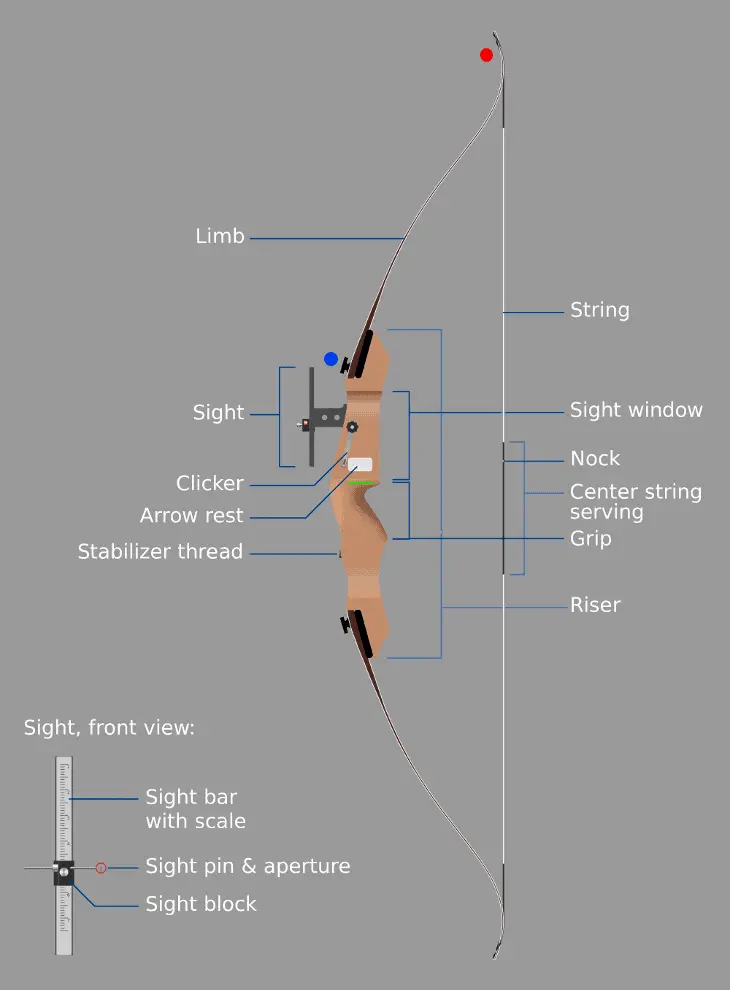The Sonoma is a really interesting model, and we’re thrilled to write about it. High-end recurves like the Sonoma tend to have a lot in common with other high-end recurves, but the Sonoma doesn’t—in fact, it features far fewer features than other takedown bows, and that makes it something of an oddity.
It’s still a great bow, though, but only for specific purposes, and we’ll get into all the below.
Let’s jump in, and we’ll start with an overview, and then the details:
SUMMARY: BEAR SONOMA RECURVE REVIEW
The Bear Sonoma features an aesthetically-pleasing reddish-brown riser with multi-laminate limbs, and despite its takedown design, the bow embraces some very spartan design elements—most notably, it has no ports/bushings for add-on gear, such as a bow sight, stabilizer, quiver, etc. That—in our humble opinion—makes it great for traditionalists who don’t use those add-ons, but not great for novice archers who need add-on gear to enhance their aim. It’s also got a high draw weight—Bear makes it in 40-pound and 45-pound options—and that’s great for bow hunters and strappin’ folk, but not great for younger archers or archers without a lot of upper-body strength. With all that said, it’s still a quality bow (and Bear is a really fantastic archery company), so if you’re looking for a traditional bow, you’re OK with shooting instinctually/without a bow sight, and can handle a heavier draw weight, this can be a nice option.
If that doesn’t describe you, and you’re new to archery, need a lower draw weight, and/or want to be able to add a bow sight, stabilizer, etc., then we’d recommend the Samick Sage Recurve Bow, which has many of the same positives as the Sonoma.
OK, let’s take a closer look.
Pros of the Sonoma
Our first “pro” speaks to the Sonoma’s quality:
Bear is a Fantastic Company and the Bow Is Well-Made
We’ll put this right up top, because Bear, as a company, stands out from a lot of other bow manufacturers. They have a decades-old reputation as a maker of quality recurve bows, and the Sonoma is actually designed to be a little more “high-end” than other comparable bows: it’s a little sturdier than the PSE Razorback (review), and a little more rugged than the SAS Courage. The Sonoma features a solid design, and that’s more than half-the-battle when it comes to recurves.
The strength of the model is in its structure, and it features a compressed wooden riser that has a little more volume than similar bows, and the limbs are a multi-laminate / fiberglass combo that are designed to resist flex—the bow has a fairly heavy draw weight; more on that later—while also resisting limb twist. It’s designed not only to shoot with strength, but to last a while (and that’s one of the most important aspects of a bow—how long it will last).
Bear is one of our favorite archery companies, and Fred Bear, the founder of the company and its namesake, is something of a legend in the archery world, and if you like to get swept up in the historical/nostalgic aspects of archery, that sort of thing can be very fun to explore.
It’s Good Option for Bow Hunting
As we’ve mentioned elsewhere, we have to be very careful when it comes to recommending recurve bows for bow hunting. The fact is, it’s a heck-of-a-lot easier to go bow hunting with a compound bow, and many of the mass-market recurve bows aren’t really up to the task. They’re fun to shoot, and they’re great for introducing new archers to the sport, but they’re not reliable enough to put down game—especially big game.
Bear bows don’t usually have that problem, and neither does the Sonoma—it’s one of the few recurve bows we can recommend for hunting, because it’s designed for accuracy (it’s got a generous shelf with lining, to provide some “give” for arrows traveling over it), and it’s manufactured in draw weights that usually meet state-regulated draw weights. In many states, the minimum required draw weight for hunting game like deer is 35 pounds, and the Bear Sonoma is manufactured only in draw weights of 40 and 45 pounds. So you should be good to go, if you’re bow hunting.
It’s also lightweight, and it’s fairly silent, but you can reduce some of the twang/vibration with some string tassels. Recurve bows, by their nature, can be pretty loud—after you release the bow string, the string hits the top and bottom limb where they curve forward—and that can result in some noise that scares off game. That’s something you may want to look into if you’ll be bow hunting.
With that said… if you *do* hunt with it, we’d urge you to truly develop your skill set. Be certain that you’re accurate enough to put your arrows exactly where you want them, because as we’ll explain in a minute, this bow doesn’t allow you to add a bow sight, and that’s a must-have for a lot of bow hunters.
The Sonoma is Easy to Assemble
It’s not as easy as some of the more “mainstream” bows that you can assemble with your bare hands, but it’s pretty easy to put together. You need an Allen wrench to screw in the limbs to the riser, and a bow stringer to get the string on the bow after you’ve set it up, and then… you’re good to go! Not too difficult.
It Can Be a Great Option for Traditionalists
The bow features no ports/bushings for add-ons, so you can’t add a bow sight, stabilizer, or any other piece of gear (and we’ll talk about this in our “cons” section below).
There are no holes in the riser that take from its structural integrity, and there’s no altering this bow in any way (unless you drill holes yourself, which we *do not* recommend). If you like traditional archery—that is, archery that foregoes all of those add-ons—this can be a great pick.
The Bow Is One Handsome Fella
We won’t harp on this for too long, because may you like the look of it and maybe you don’t—that’s up to you—but for us, the Sonoma meets Bear’s high standard for bow aesthetics. It’s sleek, it’s streamlined, its riser is a deep reddish-brown and is contoured to melt into the hand. It’s really nice to look at.
The interesting design point on the riser of the Sonoma, however, is its depth—the distance from the front of the riser to the back of the riser is a little greater than you may see on bows of this type, and it gives it a solid, almost “medieval” look. It’s worth noting that the riser isn’t unnecessarily wide, so it’s not any more difficult to grasp than similar recurves.
Alright, so there’s a lot to like. But our Bear Sonoma Recurve review wouldn’t be complete without some good old complainin,’ so let’s take a look at some of the factors that may scare some folks away:

Cons of the Sonoma
We’ll keep these brief:
No Ports for Accessories
The biggest “con” against the Sonoma is that the riser features no locations for add-ons, and you can’t dress it up in any way.
That literally means you can’t add any gear to it: no bow sight, no stabilizer, no quiver, nothing. For a lot of archers who are into traditional hunting, that’s not a “con” at all—as we mentioned above, that would be a huge “pro.
But for a lot of people—particularly novice archers and younger archers—that’s a con, because that gear can help a lot.
Available in a Restricted Range of Draw Weights
The second con is that Bear only manufactures the bow in two draw weights: 40 pounds and 45 pounds. Most bows are made in a wider range of draw weights, and if you look at comparable bows (like the Spyder Recurve Bow), they’re made in draw weights of 20, 25, 30, 35, 40, 45, 50, 55, and 60 pounds. That range means there’s something for almost all archers, from youths and people with less upper-body strength, to stronger adults who can pull a lot of draw weight. Having only two draws weights to choose from makes this a much-less popular bow.
And the draw weights themselves are a little bit high! 40 and 45 is good for bow hunters, but it’s not great for new archers who are building their strength—pulling that kind of weight can tucker you out after a while—and that can make longer practice sessions difficult.
So the draw weight is a mark against the bow, in our minds, and along with the lack of ports for add-ons, says to us that…
It’s Not *Really* a Youth Bow, Even Though Everyone Says It Is
We’ve seen a couple of reviewers suggest that the Sonoma is a great youth bow, but we think you need to be careful when you say that this is a “youth” bow. It can be, but it’s not like most youth bows out there, and we think it would actually be a bad choice for a lot of young people. There are only two reasons why we think that, but they’re strong reasons:
> As we mentioned earlier, it doesn’t come with ports for a bow sight, stabilizer, quiver, etc. Those tools make it much, much easier to shoot, and make it much, much easier to shoot accurately—especially when you’re just starting out; and
> The draw weights offered are really high for a young person. Youths usually start out somewhere around 20 pounds, and work their way up to higher draw weights as they gain strength. 40 and 45 pounds is really high for a younger person.
So, here’s our recommendation: this *can* be a good bow for youths, but ONLY if that youth is very familiar with bows, is very strong, and can shoot without a bow sight (or have the patience to learn!). If you are totally new to archery, or if you don’t have much upper body strength, this probably isn’t a good pick.
The fact is, that does not describe most youths—most youths (and adults, if we’re being honest) need some sort of bow sight to help them aim.
So, Let’s Pull This All Together
While we think this is a quality bow and another great offering from Bear, we need to be very clear: it’s not for everybody. If you’re new to archery and haven’t built much upper-body strength, and/or if you need a bow sight to aim (which describes most new archers, and probably most archers in general), we think you should look elsewhere (and the Samick Sage Recurve Bow can be a great place to start).
If, however, you have a fair bit of upper-body strength, are comfortable shooting without a bow sight (or are willing to learn), and/or love traditional archery, this can be a really fantastic choice.
OK—we think we did a good job covering all the unique angles of the Sonoma. We hope that helps—good luck, have fun, and be well!





